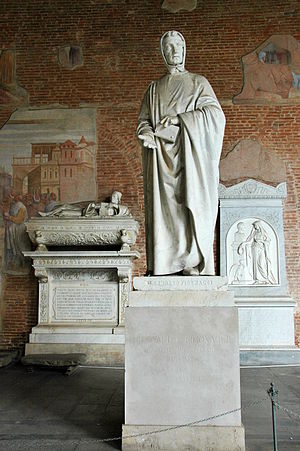Fibonacci

Fibonacci, also known as Leonardo Bonacci, Leonardo Fibonacci and Leonardo of Pisa, lived c. 1170–1250. He was an Italian mathematician.[1] He was thought "the most talented Western mathematician of the Middle Ages".[2][3]
Fibonacci popularized the Hindu–Arabic numeral system to the Western World.[4] He did this in his composition in 1202 of Liber Abaci (Book of Calculation).[5] He also introduced to Europe the sequence of Fibonacci numbers which he used as an example in Liber Abaci.[6]
Fibonacci number sequence
Fibonacci is best known for the list of numbers called the Fibonacci Sequence. The list never stops, but it starts this way:
1, 1, 2, 3, 5, 8, 13, 21, 34, 55, 89, 144, 233, 377, 610, 987, 1597, 2584...
In this list, a person can find the next number by adding the last two numbers together.
1 + 1 = 2
1 + 2 = 3
2 + 3 = 5
3 + 5 = 8
5 + 8 = 13
8 + 13 = 21
13 + 21 = 34
21 + 34 = 55
34 + 55 = 89
55 + 89 = 144
89 + 144 = 233
144 + 233 = 377
233 + 377 = 610
377 + 610 = 987
610 + 987 = 1597
987 + 1597 = 2584
etc...
This series is also interesting because the ratio of two adjacent numbers in the series approaches the golden ratio.[7]
Fibonacci Media
A page of Fibonacci's Liber Abaci from the Biblioteca Nazionale di Firenze showing (in box on right) the Fibonacci sequence with the position in the sequence labeled with Latin numbers and Roman numerals and the value in Hindu-Arabic numerals.
References
- ↑ "The Fibonacci Series – Biographies – Leonardo Fibonacci (ca.1175 – ca.1240)". Library.thinkquest.org. Archived from the original on 2010-02-05. Retrieved 2010-08-02.
- ↑ Eves, Howard. An Introduction to the History of Mathematics. Brooks Cole, 1990: ISBN 0-03-029558-0 (6th ed.), p 261.
- ↑ "Famous Mathematicians – The Greatest Mathematicians of All Time".
- ↑ "Fibonacci Numbers". www.halexandria.org.
- ↑ Leonardo Pisano – page 3: "Contributions to number theory". Encyclopædia Britannica Online, 2006. Retrieved 18 September 2006.
- ↑ Singh, Parmanand. "Acharya Hemachandra and the (so called) Fibonacci Numbers". Math. Ed. Siwan , 20(1):28–30, 1986. ISSN 0047-6269]
- ↑ Livio, Mario. (2003). The Golden Ratio: The Story of Phi, the World's Most Astonishing Number, pp. 96-97.